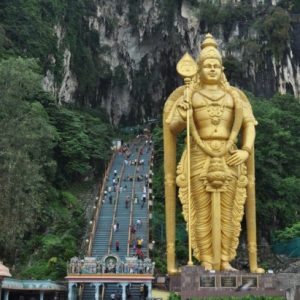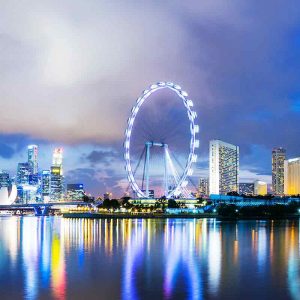Malaysia
Malaysia is a federal constitutional monarchy located in Southeast Asia. It consists of thirteen states and three federal territories and has a total landmass of 329,847 square kilometres (127,350 sq mi) separated by the South China Sea into two similarly sized regions,Peninsular Malaysia and East Malaysia (Malaysian Borneo). Peninsular Malaysia shares a land and maritime border with Thailand and maritime borders with Singapore, Vietnam, andIndonesia. East Malaysia shares land and maritime borders with Brunei and Indonesia and a maritime border with the Philippines and Vietnam. The capital city is Kuala Lumpur, whilePutrajaya is the seat of the federal government. With a population of over 30 million, Malaysia is the 44th most populous country. The southernmost point of continental Eurasia, Tanjung Piai, is in Malaysia. Located in the tropics, Malaysia is one of 17 megadiverse countries on earth, with large numbers of endemic species.
Malaysia has its origins in the Malay kingdoms present in the area which, from the 18th century, became subject to the British Empire. The first British territories were known as the Straits Settlements, whose establishment was followed by the Malay kingdoms becoming British protectorates. The territories on Peninsular Malaysia were first unified as the Malayan Union in 1946. Malaya was restructured as the Federation of Malaya in 1948, and achieved independence on 31 August 1957. Malaya united with North Borneo, Sarawak, and Singaporeon 16 September 1963. Less than two years later in 1965, Singapore was expelled from the federation.
The country is multi-ethnic and multi-cultural, which plays a large role in politics. Theconstitution declares Islam the state religion while allowing freedom of religion for non-Muslims. The government system is closely modelled on the Westminster parliamentary system and the legal system is based on common law. The head of state is the king, known as the Yang di-Pertuan Agong. He is an elected monarch chosen from the hereditary rulers of the nine Malay states every five years. The head of government is the prime minister.
Since its independence, Malaysia has had one of the best economic records in Asia, with itsGDP growing at an average of 6.5% per annum for almost 50 years. The economy has traditionally been fuelled by its natural resources, but is expanding in the sectors of science, tourism, commerce and medical tourism. Today, Malaysia has a newly industrialised market economy, ranked third largest in Southeast Asia and 29th largest in the world. It is a founding member of the Association of Southeast Asian Nations, the East Asia Summit and theOrganisation of Islamic Cooperation, and a member of Asia-Pacific Economic Cooperation, theCommonwealth of Nations, and the Non-Aligned Movement.
The name “Malaysia” is a combination of the word “Malay” and the Latin-Greek suffix “-sia”/-σία The word “melayu” in Malay may derive from the Tamilwords “malai” and “ur” meaning “mountain” and “city, land”, respectively. “Malayadvipa” was the word used by ancient Indian traders when referring to the Malay Peninsula. Whether or not it originated from these roots, the word “melayu” or “mlayu” may have been used in early Malay/Javaneseto mean to steadily accelerate or run. This term was applied to describe the strong current of the river Melayu in Sumatra. The name was later adopted by the Melayu Kingdom that existed in the seventh century on Sumatra.
Before the onset of European colonisation, the Malay Peninsula was known natively as “Tanah Melayu” (“Malay Land”). Under a racial classification created by a German scholar Johann Friedrich Blumenbach, the natives of maritime Southeast Asia were grouped into a single category, the Malay race. Following the expedition of French navigator Jules Dumont d’Urvilleto Oceania in 1826, he later proposed the terms of “Malaysia”, “Micronesia” and “Melanesia” to the Société de Géographie in 1831, distinguishing these Pacific cultures and island groups from the existing term “Polynesia”. Dumont d’Urville described Malaysia as “an area commonly known as the East Indies”. In 1850, the English ethnologist George Samuel Windsor Earl, writing in the Journal of the Indian Archipelago and Eastern Asia, proposed naming the islands of Southeast Asia as “Melayunesia” or “Indunesia”, favouring the former. In modern terminology, “Malay” remains the name of an ethnoreligious group of Austronesian people predominantly inhabiting the Malay Peninsula and portions of the adjacent islands of Southeast Asia, including the east coast of Sumatra, the coast of Borneo, and smaller islands that lie between these areas.
The state that gained independence from the United Kingdom in 1957 took the name the “Federation of Malaya”, chosen in preference to other potential names such as “Langkasuka”, after the historic kingdom located at the upper section of the Malay Peninsula in the first millennium CE. The name “Malaysia” was adopted in 1963 when the existing states of the Federation of Malaya, plus Singapore, North Borneo and Sarawak formed a new federation. One theory posits the name was chosen so that “si” represented the inclusion of Singapore, North Borneo, and Sarawak to Malaya in 1963. Politicians in the Philippines contemplated renaming their state “Malaysia” before the modern country took the name.
Evidence of modern human habitation in Malaysia dates back 40,000 years. In the Malay Peninsular, the first inhabitants are thought to be Negritos. Traders and settlers from India and China arrived as early as the first century AD, establishing trading ports and coastal towns in the second and third centuries. Their presence resulted in strong Indian and Chinese influences on the local cultures, and the people of the Malay Peninsula adopted the religions of Hinduism and Buddhism. Sanskrit inscriptions appear as early as the fourth or fifth century. The Kingdom of Langkasuka arose around the second century in the northern area of the Malay Peninsula, lasting until about the 15th century. Between the 7th and 13th centuries, much of the southern Malay Peninsula was part of the maritime Srivijaya Empire. After the fall of Srivijaya, the Majapahit Empire had influence over most of Peninsular Malaysia and the Malay Archipelago. Islam began to spread among Malays in the 14th century. In the early 15th century, Sultan Iskandar Shah, a runaway king of the former Kingdom of Singapura, founded theMalacca Sultanate, commonly considered the first independent state in the peninsula area. Malacca was an important commercial centre during this time, attracting trade from around the region.
In 1511, Malacca was conquered by Portugal, after which it was taken by the Dutch in 1641. In 1786, the British Empire established a presence in Malaya, when the Sultan of Kedah leased Penang Island to the British East India Company. The British obtained the town of Singapore in 1819, and in 1824 took control of Malacca following the Anglo-Dutch Treaty. By 1826, the British directly controlled Penang, Malacca, Singapore, and the island of Labuan, which they established as the crown colony of the Straits Settlements. By the 20th century, the states of Pahang, Selangor, Perak, and Negeri Sembilan, known together as the Federated Malay States, had British residents appointed to advise the Malay rulers, to whom the rulers were bound to defer to by treaty. The remaining five states in the peninsula, known as the Unfederated Malay States, while not directly under British rule, also accepted British advisers around the turn of the 20th century. Development on the peninsula and Borneo were generally separate until the 19th century. Under British rule the immigration of Chinese and Indians to serve as labourers was encouraged. The area that is now Sabah came under British control as North Borneo when both the Sultan of Brunei and the Sultan of Sulu transferred their respective territorial rights of ownership, between 1877 and 1878. In 1842, Sarawak was ceded by the Sultan of Brunei to James Brooke, whose successors ruled as the White Rajahs over an independent kingdom until 1946, when it became a crown colony.
In the Second World War, the Japanese Army invaded and occupied Malaya, North Borneo, Sarawak, and Singapore for over three years. During this time, ethnic tensions were raised and nationalism grew. Popular support for independence increased after Malaya was reconquered, by Allied forces. Post-war British plans to unite the administration of Malaya under a single crown colony called the “Malayan Union” met with strong opposition from the Malays, who opposed the weakening of the Malay rulers and the granting of citizenship to the ethnic Chinese. The Malayan Union, established in 1946, and consisting of all the British possessions in the Malay Peninsula with the exception of Singapore, was quickly dissolved and replaced on 1 February 1948 by the Federation of Malaya, which restored the autonomy of the rulers of the Malay states under British protection. During this time, mostly Chinese rebels under the leadership of the Malayan Communist Party launched guerrilla operations designed to force the British out of Malaya. The Malayan Emergency lasted from 1948 to 1960, and involved a long anti-insurgency campaign by Commonwealth troops in Malaya. After this a plan was put in place to federate Malaya with the crown colonies of North Borneo (which joined as Sabah), Sarawak, and Singapore. The proposed date of federation was 31 August 1963; however, the date was delayed until 16 September 1963 due to opposition from Indonesia’s Sukarno and theSarawak United Peoples’ Party.
Federation brought heightened tensions including a conflict with Indonesia, Singapore’s eventual exit in 1965, and racial strife. This strife culminated in the 13 May race riots in 1969. After the riots, the controversial New Economic Policy was launched by Prime Minister Tun Abdul Razak, trying to increase the share of the economy held by the bumiputera. Under Prime Minister Mahathir Mohamad there was a period of rapid economic growth and urbanisation beginning in the 1980s. The economy shifted from being agriculturally based to one based on manufacturing and industry. Numerous mega-projects were completed, such as the Petronas Towers, the North-South Expressway, the Multimedia Super Corridor, and the new federal administrative capital of Putrajaya. However, in the late 1990s the Asian financial crisis almost caused the collapse of the currency and the stock and property markets.
The Malaysian constitution says it guarantees freedom of religion while making Islam the state religion. According to the Population and Housing Census 2010 figures, ethnicity and religious beliefs correlate highly. Approximately 61.3% of the population practice Islam, 19.8% practice Buddhism, 9.2% Christianity, 6.3% Hinduism and 1.3% practice Confucianism, Taoism and other traditional Chinese religions. 0.7% declared no religion and the remaining 1.4% practised other religions or did not provide any information. Sunni Islam of Shafi’i school of jurisprudence is the dominant branch of Islam in Malaysia.
The Malaysian constitution strictly defines what makes a “Malay”, considering Malays those who are Muslim, speak Malay regularly, practise Malay customs, and lived in or has ancestors from Brunei, Malaysia and Singapore. Statistics from the 2010 Census indicate that 83.6% of the Chinese population identify as Buddhist, with significant numbers of adherents following Taoism (3.4%) and Christianity (11.1%), along with small Hui-Muslim populations in areas like Penang. The majority of the Indian population follow Hinduism (86.2%), with a significant minority identifying as Christians (6.0%) or Muslims (4.1%). Christianity is the predominant religion of the non-Malay bumiputera community (46.5%) with an additional 40.4% identifying as Muslims.
Muslims are obliged to follow the decisions of Syariah courts in matters concerning their religion. The Islamic judges are expected to follow the Shafi’i legal school of Islam, which is the main madh’hab of Malaysia. The jurisdiction of Syariah courts is limited to Muslims in matters such as marriage, inheritance, divorce, apostasy, religious conversion, and custody among others. No other criminal or civil offences are under the jurisdiction of the Shariah courts, which have a similar hierarchy to the Civil Courts. Despite being the supreme courts of the land, the Civil Courts do not hear matters related to Islamic practices.
The official and national language of Malaysia is Malaysian, a standardised form of the Malay language. The terminology as per government policy is Bahasa Malaysia (literally “Malaysian language”) but legislation continues to refer to the official language as Bahasa Melayu (literally “Malay language”). The National Language Act 1967 specifies the Latin (Rumi) script as the official script of the national language, but does not prohibit the use of the traditional Jawi script.
English remains an active second language, with its use allowed for some official purposes under the National Language Act of 1967. In Sarawak English is an official state language alongside Malaysian. Historically English was the de facto administrative language, with Malay becoming predominant after the 1969 race riots. Malaysian English, also known as Malaysian Standard English, is a form of English derived from British English. Malaysian English is widely used in business, along with Manglish, which is a colloquial form of English with heavy Malay, Chinese, and Tamil influences. The government discourages the use of non-standard Malay but has no power to issue compounds or fines to those who use improper Malay on their advertisements.
Many other languages are used in Malaysia, which contains speakers of 137 living languages. Peninsular Malaysia contains speakers of 41 of these languages. The native tribes of East Malaysia have their own languages which are related to, but easily distinguishable from, Malay. Iban is the main tribal language in Sarawak while Dusunic and Kadazan languages are spoken by the natives in Sabah. Chinese Malaysians predominantly speak Chinese dialects from the southern provinces of China. The more common Chinese varieties in the country are Cantonese, Mandarin, Hokkien, Hakka, Hainanese, and Fuzhou. Tamil is used predominantly by Tamils, who form a majority of Malaysian Indians. Other South Asian languages are also widely spoken in Malaysia, as well as Thai A small number of Malaysians have Caucasian ancestry and speak creole languages, such as the Portuguese-based Malaccan Creoles, and the Spanish-based Chavacano language.
Malaysia has a multi-ethnic, multicultural, and multilingual society. The original culture of the area stemmed from indigenous tribes that inhabited it, along with the Malays who later moved there. Substantial influence exists from Chinese and Indian culture, dating back to when foreign trade began. Other cultural influences include the Persian, Arabic, and British cultures. Due to the structure of the government, coupled with the social contract theory, there has been minimal cultural assimilation of ethnic minorities.
In 1971, the government created a “National Cultural Policy”, defining Malaysian culture. It stated that Malaysian culture must be based on the culture of the indigenous peoples of Malaysia, that it may incorporate suitable elements from other cultures, and that Islam must play a part in it. It also promoted the Malay language above others. This government intervention into culture has caused resentment among non-Malays who feel their cultural freedom was lessened. Both Chinese and Indian associations have submitted memorandums to the government, accusing it of formulating an undemocratic culture policy.
Some cultural disputes exist between Malaysia and neighboring countries, notably Indonesia. The two countries have a similar cultural heritage, sharing many traditions and items. However, disputes have arisen over things ranging from culinary dishes to Malaysia’s national anthem. Strong feelings exist in Indonesia about protecting their national heritage. The Malaysian government and the Indonesian government have met to defuse some of the tensions resulting from the overlaps in culture. Feelings are not as strong in Malaysia, where most recognize that many cultural values are shared.
wordpress theme by initheme.com
Total: 1 tour . Showing 1 - 1 view all
Search for Tour
Not what you're looking for? Try your search again









